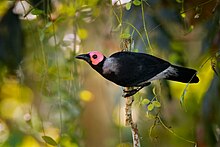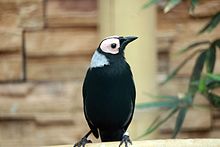Coleto
| Coleto | |
|---|---|

| |
| Scientific classification | |
| Domain: | Eukaryota |
| Kingdom: | Animalia |
| Phylum: | Chordata |
| Class: | Aves |
| Order: | Passeriformes |
| Family: | Sturnidae |
| Genus: | Sarcops Walden, 1875 |
| Species: | S. calvus
|
| Binomial name | |
| Sarcops calvus | |
| Synonyms | |
|
Gracula calva Linnaeus, 1766 | |
The coleto (Sarcops calvus) is a starling species (family Sturnidae) in the monotypic genus Sarcops. It is endemic to the Philippines. Its natural habitats are tropical dry forest, tropical moist lowland forest, and subtropical or tropical moist montane forest. In Filipino and Tagalog, this bird is known as kuling or koleto,[2] while in Central Visayas, it is commonly known as the sal-ing.[1]
Description and taxonomy
[edit]EBird describes the bird as " A fairly large bird of forest canopy and more open wooded areas from the lowlands to low elevations in the mountains. Often seen on exposed snags. Pale gray from the back of the neck down the back to the rump and the sides. The rest of the underparts and wings are black. Head mostly covered with bare pink skin. Unmistakable. Voice includes a mixture of clicks, squeals, metallic warbling, and piping notes."[3]

In 1760 the French zoologist Mathurin Jacques Brisson included a description of the coleto in his Ornithologie based on a specimen collected in the Philippines. He used the French name Le merle chauve des Philippines and the Latin Mname "erula Calva Philippensis.[4] Although Brisson coined Latin names, these do not conform to the binomial system and are not recogniszd by the International Commission on Zoological Nomenclature.[5] WI 1766 , when the Swedish naturalist Carl Linnaeus updated his Systema Naturae for the twelfth edition, he added 240 species that had been previously described by Brisson.[5] One of these was the coleto. Linnaeus included a brief description, coined the binomial name Gracula calva and cited Brisson's work.[6] The specific name is from Latin calvus "bald" or "without hair".[7] This species is now the only member of the genus Sarcops that was introduced by the English ornithologist Arthur Walden in 1875.[8] The name combines the Ancient Greek words sarx, sarkos "flesh" and ōps, ōpos "face" or "complexion".[9]
Subspecies
[edit]Three subspecies are recognised:[10]
- S. c. calvus (Linnaeus, 1766) – north Philippines
- S. c. melanonotus (Ogilvie-Grant, 1906) – central and south Philippines
- S. c. lowii (Sharpe, 1877) – Sulu Archipelago (southwest Philippines)
Ecology and behavior
[edit]Feeds on fruit, berries, small insects and nectar. Forages singly, in pairs and occasionally in small groups of up to 25, in fruiting trees. Breeds from March to September. Nests in cavities in dead trees. Clutch size is typically 2 to 3 eggs.[11]
The Coleto was a recently discovered host of the brood parasitic Asian Koel (Eudynamys scolopaceus) in the Philippines.[12]
Habitat and conservation status
[edit]This bird's habitat is primary and secondary forest and scrubland up to 1,000 meters above sea level.
IUCN has assessed this bird as least-concern species as it has a large range and is common throughout. However, deforestation in the Philippines continues throughout the country due to slash and burn farming, mining, illegal logging and habitat conversion. It is widely caught for the pet trade as it has the ability to copy human speech. [13]
References
[edit]- ^ a b BirdLife International (2016). "Sarcops calvus". IUCN Red List of Threatened Species. 2016: e.T22710985A94271063. doi:10.2305/IUCN.UK.2016-3.RLTS.T22710985A94271063.en. Retrieved 12 November 2021.
- ^ "Coleto". Project Noah. Retrieved 2023-03-30.
- ^ "Coleto - eBird". ebird.org. Retrieved 2024-09-09.
- ^ Brisson, Mathurin Jacques (1760). Ornithologie, ou, Méthode contenant la division des oiseaux en ordres, sections, genres, especes & leurs variétés (in French and Latin). Vol. 2. Paris: Jean-Baptiste Bauche. pp. XXX, Plate 26 fig 2. The two stars (**) at the start of the section indicates that Brisson based his description on the examination of a specimen.
- ^ a b Allen, J.A. (1910). "Collation of Brisson's genera of birds with those of Linnaeus". Bulletin of the American Museum of Natural History. 28: 317–335. hdl:2246/678.
- ^ Linnaeus, Carl (1766). Systema naturae : per regna tria natura, secundum classes, ordines, genera, species, cum characteribus, differentiis, synonymis, locis (in Latin). Vol. 1, Part 1 (12th ed.). Holmiae (Stockholm): Laurentii Salvii. p. 164.
- ^ Jobling, J.A. (2018). del Hoyo, J.; Elliott, A.; Sargatal, J.; Christie, D.A.; de Juana, E. (eds.). "Key to Scientific Names in Ornithology". Handbook of the Birds of the World Alive. Lynx Edicions. Retrieved 12 May 2018.
- ^ Walden, Arthur (1875). "A list of the birds known to inhabit the Philippine Archipelago". Transactions of the Zoological Society of London. 9 (2): 125–252 [205]. doi:10.1111/j.1096-3642.1875.tb00238.x.
- ^ Jobling, J.A. (2018). del Hoyo, J.; Elliott, A.; Sargatal, J.; Christie, D.A.; de Juana, E. (eds.). "Key to Scientific Names in Ornithology". Handbook of the Birds of the World Alive. Lynx Edicions. Retrieved 12 May 2018.
- ^ Gill, Frank; Donsker, David, eds. (2018). "Nuthatches, Wallcreeper, treecreepers, mockingbirds, starlings, oxpeckers". World Bird List Version 8.1. International Ornithologists' Union. Retrieved 12 May 2018.
- ^ Craig, Adrian J. F.; Feare, C. J. (2020). "Coleto (Sarcops calvus), version 1.0". Birds of the World. doi:10.2173/bow.coleto1.01. ISSN 2771-3105.
- ^ Gicaraya, VAG; Española, CP (2023). "Brood Parasitism of the Asian Koel Eudynamys scolopaceus on the Tree Cavity-Nesting Coleto Sarcops calvus: First Record in the Philippines". Ornithological Science. 22 (2): 175–178. doi:10.2326/osj.22.175. S2CID 260203491.
- ^ IUCN (2016-10-01). Sarcops calvus: BirdLife International: The IUCN Red List of Threatened Species 2016: e.T22710985A94271063 (Report). International Union for Conservation of Nature. doi:10.2305/iucn.uk.2016-3.rlts.t22710985a94271063.en.
External links
[edit] Media related to Sarcops calvus at Wikimedia Commons
Media related to Sarcops calvus at Wikimedia Commons Data related to Sarcops calvus at Wikispecies
Data related to Sarcops calvus at Wikispecies

